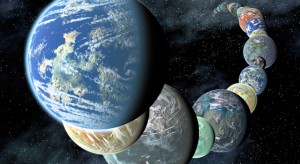
On what basis can we conclude this? Well here is some info you can dip into, JPL reports yesterday Billions and Billions of Planets … There they report ….
That’s the conclusion of a new study by astronomers at the California Institute of Technology in Pasadena, which provides yet more evidence that planetary systems are the cosmic norm. The team made their estimate while analyzing planets orbiting a star called Kepler-32 — planets that are representative, they say, of the vast majority of planets in our galaxy and thus serve as a perfect case study for understanding how most of these worlds form.
“There are at least 100 billion planets in the galaxy, just our galaxy,” says John Johnson, assistant professor of planetary astronomy at Caltech and coauthor of the study, which was recently accepted for publication in the Astrophysical Journal. “That’s mind-boggling.”
“It’s a staggering number, if you think about it,” adds Jonathan Swift, a postdoctoral student at Caltech and lead author of the paper. “Basically, there’s one of these planets per star.”
CIT describe more details here where they explain that planetary systems are the cosmic norm. So how exactly have they come to this conclusion by just looking at Keplar-32. Well,like this …
- We know that approximately 70% of all stars in the Galaxy belong to the diminutive M dwarf class
- Several thousand of these lie within the field of view of the Keplar space telescope, and a large number of these targets show planet transit signals.
- Kepler-32 is a typical star in the Kepler M dwarf sample
- They have examined the planetary architecture of this one and now know that five planets transit this star
- New observations limit possible false positive scenarios allowing them to validate the entire Kepler-32 system
- The Kepler-32 planets are representative of the full ensemble of planet candidates orbiting the Kepler M dwarfs for which they calculate an occurrence rate of 1.0 +/- 0.1 planet per star.
- The formation of the Kepler-32 planets therefore offers a plausible blueprint for the formation of one of the largest known populations of planets in our Galaxy.
Thus there are billions and billions of planets out there.
In the end, M-dwarf systems like Kepler-32′s are quite different from our own solar system. For one, M dwarfs are cooler and much smaller than the sun. Kepler-32, for example, has half the mass of the sun and half its radius. The radii of its five planets range from 0.8 to 2.7 times that of Earth, and those planets orbit extremely close to their star. The whole Kepler-32 system fits within just over a tenth of an astronomical unit (the average distance between Earth and the sun) — a distance that is about a third of the radius of Mercury’s orbit around the sun.
One further thought, this is just one galaxy, our own, we can extrapolate further out from there . There are more than enough galaxies out there for each and every human on the planet (all 7 billion) to be given a dozen galaxies each. In other words, the number of planets in the universe is such a huge number that we cannot even begin to grasp the number. The universe is so old and so huge that impossible things will happen all the time.
REFERENCES:
- Jonathan J. Swift et al., Characterizing the Cool KOIs IV: Kepler-32 as a prototype for the formation of compact planetary systems throughout the Galaxy, arxiv.org/abs/1301.0023
Of course there is. Why should earth exist on its own. I would say, when we finally complete the exploration of our own Solar System, we will have discovered ‘LIFE’ that is alien to our own. Therefore every other Star supports a ” LIFE” in some form relative to ours.